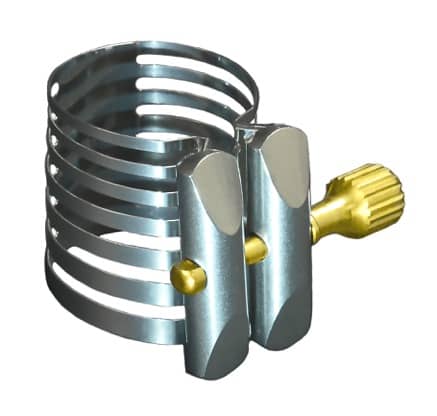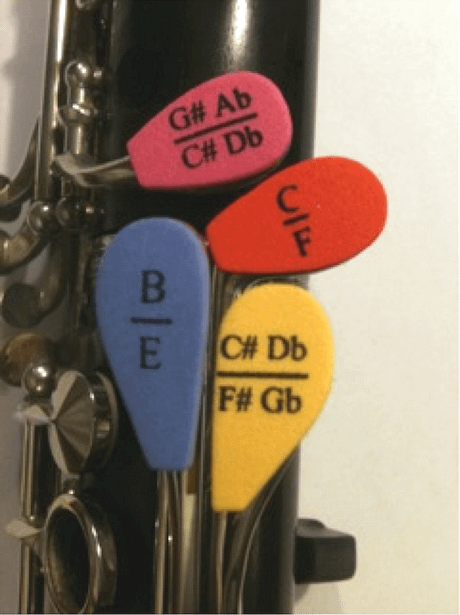-

Buffet Crampon E12F Semi-professional Clarinet
Mike Lawson | November 23, 2015
Read More...The E12F semi-professional clarinter features unstained African blackwood, silver-plated keywork, and a refined bore derived from the R13, leather pads, an adjustable thumb rest with neck strap hook, threaded posts, and a backpack-style case.
-
Rovner Products Platinum Ligature Now Available in New Size
Mike Lawson | May 6, 2015
Read More...Rovner announces its Platinum all-metal ligature now comes in size P-1E.
-
Warning: Trying to access array offset on value of type bool in /home/sbomagazine/public_html/site/wp-content/themes/timeless2021/functions.php on line 437
Warning: Trying to access array offset on value of type bool in /home/sbomagazine/public_html/site/wp-content/themes/timeless2021/functions.php on line 438
Essential for Embouchure
Mike Lawson | April 7, 2015David Snyder of Illinois State University in Normal, IL presents this month's Playing Tip.
Read More... -
Vandoren V21 Clarinet Reed
Mike Lawson | January 3, 2015A thick blank American-cut reed, the V21 is available for B-flat clarinet only in sizes 2½, 3, 3½, 3½+, 4, 4½, and 5. dansr.com Read More... -
Performance: Clarinet Class
Mike Lawson | October 18, 2014First steps for beginning students
Read More...Teaching students to play the clarinet is often both rewarding and challenging. A student’s natural enthusiasm when beginning a musical instrument is hard to match. During the first few weeks, students are introduced to embouchure, breath support, and playing their first notes on the clarinet. Some students pick up each new fundamental easily, while others require additional help. Young students are especially flexible in the beginning, allowing instruction that is not grasped to be set aside and replaced with methods that produce better results. If possible, consider meeting a beginning class during the summer band program, as this allows for working with separate instruments and individuals.
-
D’Addario Reserve Cut Clarinet Reeds
Mike Lawson | July 21, 2014The Reserve cut for clarinet is built on a standard thickness blank and features a shorter vamp, rounded tip corners, and a traditional tip thickness. Reserve Bb Clarinet reeds are offered in boxes of 10 and packs of two reeds in strengths from 2.0 to 4.5 with a special 3.0+ strength. The Reserve Classic cut […] Read More... -
Performance: Clarinet Alternations
Mike Lawson | May 19, 2014Teaching and Improving Beginning and Intermediate Clarinet Technique
Read More...One of the essential components of good musicianship is the development of great finger technique. This indispensable skill is dependent upon many factors, including correct hand position, precise finger movement, knowledge of alternate fingerings, and the ability to make the correct left and right alternative “pinky” key decisions. Utilizing this alternation method is often a mystery for both the student and the director. Band directors who are non-clarinet majors might not have ascertained this information during their undergraduate studies and, therefore, might be apprehensive in teaching this essential skill to their students.
-
Warning: Trying to access array offset on value of type bool in /home/sbomagazine/public_html/site/wp-content/themes/timeless2021/functions.php on line 437
Warning: Trying to access array offset on value of type bool in /home/sbomagazine/public_html/site/wp-content/themes/timeless2021/functions.php on line 438
Richard Saucedo: Excellence as a Lifestyle
Mike Lawson | October 13, 2010In many music education circles, Indiana's Carmel High School is already a familiar name. A finalist in the Bands of America Grand National Championships for each of the past 14 years, Carmel's Marching Greyhounds won the competition in 2005, and the high school's orchestras have recently performed at such venues as the Midwest Band & Orchestra Clinic and the Bands of America National Concert Band Festival. With approximately 600 students participating in instrumental music at Carmel High School, it may not be much of a surprise that Carmel Clay was named one of the top communities for music education in 2010 by the NAMM Foundation.
Richard Saucedo is the director of bands and chair of the performing arts department at Carmel High School, where he has taught for 29 years. Saucedo credits the success of the program to his administration's commitment to the arts, noting that this commitment has helped spark an infectious enthusiasm for music in the community, which in turn helps boost student participation and instill a pride that drives their performance level ever skyward.
For a closer look at exactly what is going on in this prolific music community, SBO recently caught up with Saucedo, a director, educator, composer, and adjudicator, who was gracious enough to provide some insight into the approach that has yielded such consistent results. Read on as Richard discusses the basics of his program and provides some tips that every director should keep in mind when preparing a marching band for festival or competition.
Read More... -
Warning: Trying to access array offset on value of type bool in /home/sbomagazine/public_html/site/wp-content/themes/timeless2021/functions.php on line 437
Warning: Trying to access array offset on value of type bool in /home/sbomagazine/public_html/site/wp-content/themes/timeless2021/functions.php on line 438
Teaching In A Changing Profession
Mike Lawson | March 27, 2009Welcome to the world of social networking. Technically speaking, a social network is a group of individuals or organizations connected by one or more specific types of interdependency, such as common values, visions, ideas, interests, financial exchange, friendship, kinship, dislike, conflict, or trade.
This Internet movement has been spreading like wildfire, and it is fueled by the technological enthusiasm of the nation's youth. There is a lot we can learn from our students and even younger colleagues who have been reared during the Internet age. Instant messaging, Facebook, MySpace, and YouTube are among the new electronic avenues on which relationships are speeding today. Music educators can and should be on the forefront of this social network tsunami. These Internet-based social networks can bring students, communities, and alumni together as never before. There are real advantages inherent in these new tools. Consider the following possibilities with Facebook and MySpace:
- Interact with your students by promoting upcoming concerts and reviewing recent recordings.
- Raise awareness by getting the word out on important issues and causes and inspire others to take action.
- Exchanges with colleagues could include swapping stories, experiences, and successful ideas.
- Connect with students by sharing photos and videos.
- Promote special events such as trips or music festivals with sneak peeks and announcements.
- Create buzz for your music program with behind-the-scene excitement, answer questions, and announce new items.
- Share tricks of the trade with successful projects or poll experts for advice.
Indiana University School of Music Program at IUPUI hosted their 18th Annual International Music Technology Conference last June. Attendees saw the first-ever clinic presentation on social networks covering MySpace, Facebook, and YouTube. The program's director, Dr. Fred Rees, believes "it is essential for music educators to •catch up' with such new, emerging technologies." Let's take a look at how they can serve you and your music program.
Read More... -
Warning: Trying to access array offset on value of type bool in /home/sbomagazine/public_html/site/wp-content/themes/timeless2021/functions.php on line 437
Warning: Trying to access array offset on value of type bool in /home/sbomagazine/public_html/site/wp-content/themes/timeless2021/functions.php on line 438
Breaking Through the Musical Ceiling
Mike Lawson | December 29, 2006In the world of serious music one of the last bastions of male dominated functions is that of orchestral conductors. It's curious that this field is still overwhelmingly male dominated, while women have reached parity in nearly all other segments of the performing world. This past September, the Minnesota Orchestra, one of the top symphonies in the United States, broke ranks and hired its first female assistant conductor, Ms. Sarah Hatsuko Hicks. There have been some very high profile women conductors in the past, including Sarah Caldwell - the famed director of the Opera Company of Boston and the first woman conductor of the Metropolitan Opera Orchestra. However, Ms. Hicks' hiring represents the first time in the 103-year history of the Minnesota Orchestra that a woman has been chosen for a conducting position. As she joins the ranks of only four female conductors among the top 26 US orchestras (according to the American Symphony Orchestra League), including the highly acclaimed JoAnn Falletta - director of the Buffalo Philharmonic, she is bound to make her mark upon the orchestral world.
Twenty to thirty years ago, many of the orchestral players were predominantly male, especially in some of the older ensembles in Europe. Only 25 years ago, Herbert von Karajan, the director of the Berlin Philharmonic, hired a female principle clarinetist, Sabine Meyer who was the only female in the orchestra at the time. The male members, who were evidently resistant to change, gave Ms. Meyer an extremely difficult time to the point that many claim she quit after only one year (although the official story is that she left of her own accord, for other reasons). Her groundbreaking acceptance into that orchestra was a pivotal point in time as the orchestra has since come to balance at nearly 50 percent female. Subsequently, Ms. Meyer has gone on to become one of the most successful clarinet soloists in the latter part of the 20th and early 21st centuries. Curiously, according to the NY Times, January 22, 2006, "After a tortuous three-year search for a new general manager, the Berlin Philharmonic made an unexpected choice in July. Pamela Rosenberg, 60, will be the first woman and the first American to administer what is arguably the world's most revered orchestra."
These important changes are certainly a step in the right direction, although the pace of change has been slow. In school bands and orchestras women have reached top positions in virtually all arenas and there is no conceivable reason why more have not reached the highest levels in professional orchestras, except that the old-fashioned barriers and mindsets simply have not yet changed. Women have become CEOs of multi-national, billion dollar corporations, and leaders of major universities and hospitals, so we can only hope that the ceiling parts and allows women conductors to ascend and have their opportunities with the great orchestras of the world.
Read More...
Warning: Undefined variable $additional_loop in /home/sbomagazine/public_html/site/wp-content/themes/timeless2021/archive.php on line 103
Warning: Attempt to read property "max_num_pages" on null in /home/sbomagazine/public_html/site/wp-content/themes/timeless2021/archive.php on line 103


 The E12F semi-professional clarinter features unstained African blackwood, silver-plated keywork, and a refined bore derived from the R13, leather pads, an adjustable thumb rest with neck strap hook, threaded posts, and a backpack-style case.
The E12F semi-professional clarinter features unstained African blackwood, silver-plated keywork, and a refined bore derived from the R13, leather pads, an adjustable thumb rest with neck strap hook, threaded posts, and a backpack-style case. 
 Rovner announces its Platinum all-metal ligature now comes in size P-1E.
Rovner announces its Platinum all-metal ligature now comes in size P-1E.


 One of the essential components of good musicianship is the development of great finger technique. This indispensable skill is dependent upon many factors, including correct hand position, precise finger movement, knowledge of alternate fingerings, and the ability to make the correct left and right alternative “pinky” key decisions. Utilizing this alternation method is often a mystery for both the student and the director. Band directors who are non-clarinet majors might not have ascertained this information during their undergraduate studies and, therefore, might be apprehensive in teaching this essential skill to their students.
One of the essential components of good musicianship is the development of great finger technique. This indispensable skill is dependent upon many factors, including correct hand position, precise finger movement, knowledge of alternate fingerings, and the ability to make the correct left and right alternative “pinky” key decisions. Utilizing this alternation method is often a mystery for both the student and the director. Band directors who are non-clarinet majors might not have ascertained this information during their undergraduate studies and, therefore, might be apprehensive in teaching this essential skill to their students.





